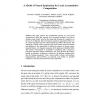Free Online Productivity Tools
i2Speak
i2Symbol
i2OCR
iTex2Img
iWeb2Print
iWeb2Shot
i2Type
iPdf2Split
iPdf2Merge
i2Bopomofo
i2Arabic
i2Style
i2Image
i2PDF
iLatex2Rtf
Sci2ools
EUROCAST
2003
Springer
2003
Springer
A Model of Neural Inspiration for Local Accumulative Computation
This paper explores the computational capacity of a novel local computational model that expands the conventional analogical and logical dynamic neural models, based on the charge and discharge of a capacity or in the use of a D flip-flop. The local memory capacity is augmented to behave as an S states automaton and some control elements are added to the memory. The analogical or digital calculus equivalent part of the balance between excitation and inhibition is also generalised to include the measure of specific spatiotemporal features over temporal expansions of the input space (dendritic field). This model is denominated as accumulative computation and is inspired in biological short-term memory mechanisms. The work describes the model‘s general specifications, including its architecture, the different working modes and the learning parameters. Then, some possible software and hardware implementations (using FPGAs) are proposed, and, finally, its potential usefulness in real time...
| Added | 06 Jul 2010 |
| Updated | 06 Jul 2010 |
| Type | Conference |
| Year | 2003 |
| Where | EUROCAST |
| Authors | José Mira, Miguel Angel Fernández, María T. López, Ana E. Delgado García, Antonio Fernández-Caballero |
Comments (0)

